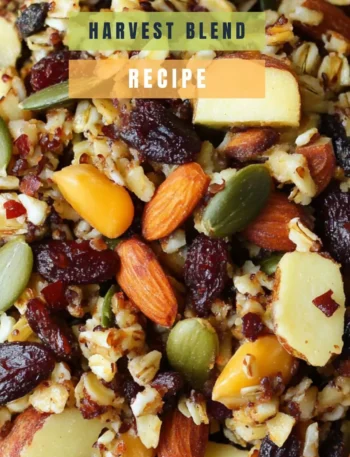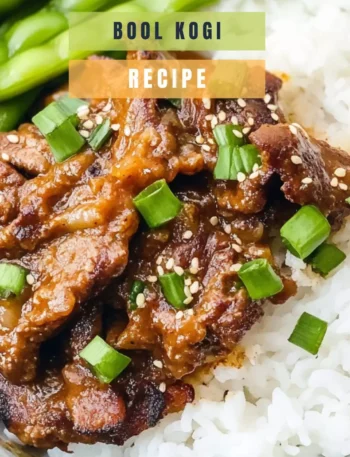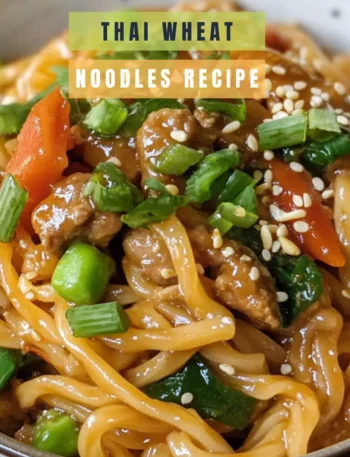Believe it or not, my first experience with Asian hot pot felt like stepping into a whole new world of flavors and textures. Picture this: a bubbling pot of rich broth at the center of the table, surrounded by a colorful array of fresh ingredients, waiting patiently to take a quick dip.
There’s something completely magical about gathering around the table with friends and family, each person customizing their bowl exactly how they like it. It’s a communal feast that speaks to the heart, celebrating connection and creativity.
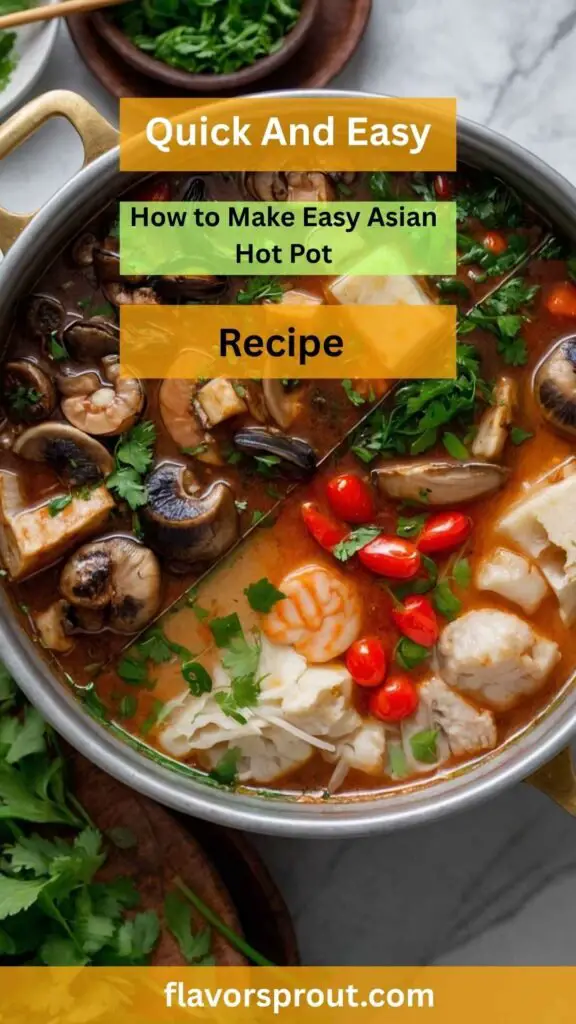
You’ll Also Like These Recipes
Pairing Your Hot Pot: What Works Best?
Before diving into the nitty-gritty of how to create an easy Asian hot pot, let’s look at what you can pair with it. Think about light, zesty sides that complement the richness of the broth. A simple cucumber salad dressed with rice vinegar and sesame oil is refreshing. It cuts through that savory heat.
For something heartier, consider a side of spring rolls or dumplings – they add just the right crunch. And don’t forget, a dish of ponzu or soy sauce for dipping adds an extra kick and balances flavors beautifully.
Why This Recipe Is Great For You
If you ask me, the beauty of hot pot lies in its versatility. I can choose whatever ingredients I’m in the mood for, or whatever my fridge offers. Plus, the cooking process is a culinary experience in itself.
Whether it’s the zing of fresh veggies or the richness of meat, every bite tells a delicious story. I’ve found that there’s something therapeutic about cooking this way. You can control portions, focus on fresh ingredients, and incorporate a variety of nutrients into your meal.
Creating this easy Asian hot pot recipe means you can easily cater to dietary preferences. Whether you’re vegetarian, vegan, or meat-loving, everyone can join in the fun. The broth serves as a perfect base for all kinds of goodies. Let’s get cooking!
Ingredients
Here’s a handy list of everything you need for this delightful dish:
1 tablespoon McCormick® Garlic Powder – This brings savory depth to your broth.
2 tablespoons freshly squeezed lime juice – For that citrusy finish.
¼ cup Thai Kitchen® Red Curry Paste – Adds a bold, spicy base.
1 large sweet onion, finely sliced into thin strips – Sweet, aromatic layers of flavor.
2 tablespoons low-sodium soy sauce – For balance.
8 cups (two 32-ounce cartons) of rich beef stock, preferably Kitchen Basics® Original – The foundation of our flavorful broth.
1 teaspoon toasted sesame oil – This will add a lovely nutty undertone.
1 tablespoon McCormick® Ground Ginger – For warmth and aromatic notes.
2 teaspoons neutral vegetable oil, such as canola or sunflower – For sautéing your onion.
1 tablespoon firmly packed light brown sugar – Enhances the umami taste.
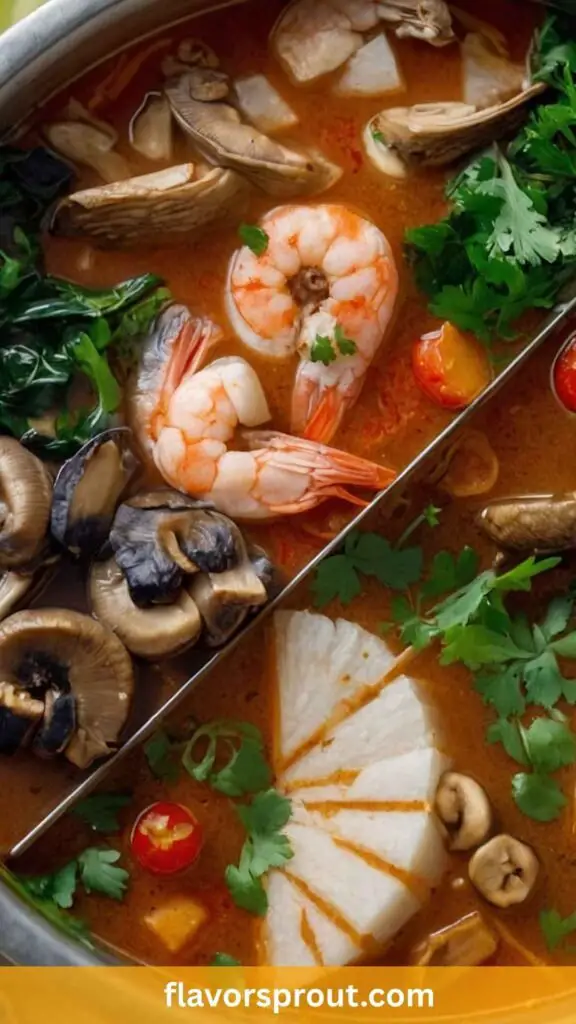
How to Make Easy Asian Hot Pot
Step 1: Prepare the Broth
First things first, let’s whip up that broth. In a large pot, heat the vegetable oil over medium heat. Once it’s shimmering, toss in the sliced onion. I love the way the aroma fills the kitchen—there’s something so comforting about sautéing onions. Cook them for about 5-7 minutes, stirring occasionally, until they’re soft and translucent.
Next, stir in the garlic powder and ground ginger. This combination is powerful; it’s like giving your broth a warm hug. Then, add the red curry paste, soy sauce, brown sugar, and lime juice. Stir this mixture for a minute or two to let all those vibrant flavors meld together.
Gradually pour in the beef stock, and bring everything to a gentle simmer. Let it bubble away for about 15 minutes. This is your core broth, and it’s going to be rich and delicious!
Step 2: Prepare Your Ingredients
While that broth simmers, it’s time to prepare your protein and veggie lineup. You can be as creative as you want. For example, thinly slice beef or chicken for quick cooking. Even shrimp works wonderfully! I like to have a variety of textures, so I usually aim for colorful veggies like shiitake mushrooms, napa cabbage, bell peppers, and bok choy. They all add unique flavors and enhance the fun of dipping.
Arrange your ingredients on a large platter. Make it colorful! This presentation awakens excitement. When your friends see all those lovely colors, they can’t help but get intrigued and start experimenting with combinations.
Step 3: Set Up the Hot Pot
With the table set, place the pot with the simmering broth right in the middle. Now, this is where it gets fun! Everyone can dive in and choose what they want to cook.
Use chopsticks or a slotted spoon to add your chosen ingredients into the bubbling broth. They’ll cook quickly—typically just a couple of minutes for veggies and proteins. The anticipation builds as you wait. Is the beef tender? Is the cabbage crisp?
Step 4: Enjoy the Feast
Once cooked, retrieve your goodies with a slotted spoon. If you’re feeling adventurous, you can dip them in your favorite sauce before enjoying. If you like a spicy kick, a sriracha mix or chili oil works wonders. Enjoy the meal together, share the flavors, and don’t hesitate to play mixologist with the ingredients.
Nutrition Information
Recipe Notes
Let’s break down these ingredients a bit:
Garlic Powder: It enhances the savory notes. Fresh garlic is lovely, but I find garlic powder gives a consistent flavor throughout the broth without the risk of burning that fresh garlic has.
Lime Juice: Fresh acidity is critical. It brightens the dish and cuts through the richness of the stock.
Red Curry Paste: This isn’t just spicy; it’s layered with flavors of herbs and spices. It packs a punch.
Onion: A must in most kitchens, onions lay the foundation for flavor in countless recipes.
Soy Sauce: Look for low-sodium varieties. This helps maintain balance without overwhelming the dish with saltiness.
Beef Stock: A quality stock makes a significant difference. It’s the soul of your hot pot.
Toasted Sesame Oil: This little addition adds a complex depth that is both nutty and slightly sweet.
Ginger: This spice is aromatic and adds warmth. Fresh ginger works beautifully as well.
Vegetable Oil: Use a neutral oil to avoid interfering with the flavors in your broth.
Brown Sugar: It helps mellow out the spices while enhancing the overall taste.

Recipe Variations
Feel free to tweak this recipe based on your preferences. Here are a few fun twists:
Seafood Hot Pot: Swap the beef for an assortment of seafood, like squid, scallops, and fish. Just ensure you adjust the cook time accordingly.
Vegetarian/ Vegan Hot Pot: Use vegetable stock and load up on tofu, mushrooms, and a variety of veggies.
Spicy Version: Add more red curry paste or include slices of fresh jalapeños for heat.
Cheesy Hot Pot: A quirky take! Throw in some mozzarella balls to add an unexpected twist.
Herbaceous Touch: After serving, sprinkle fresh cilantro or green onions on top for a fresh burst.
Noodle Add-in: Cook some noodles of your choice separately and add them to the hot pot to soak up all that flavor.
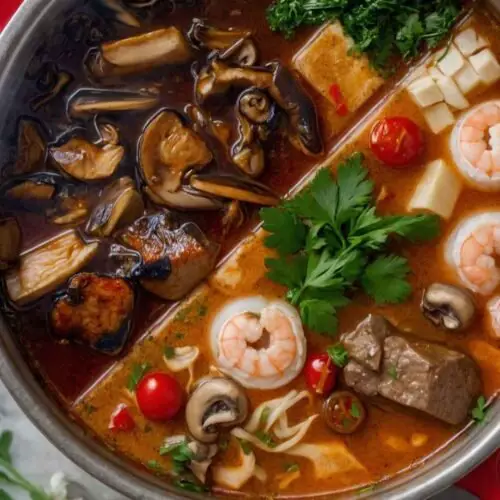
Asian Hot Pot
Equipment
- Cup, Spoon
Ingredients
- 1 tablespoon McCormick® Garlic Powder – This brings savory depth to your broth.
- 2 tablespoons freshly squeezed lime juice – For that citrusy finish.
- ¼ cup Thai Kitchen® Red Curry Paste – Adds a bold spicy base.
- 1 large sweet onion finely sliced into thin strips – Sweet, aromatic layers of flavor.
- 2 tablespoons low-sodium soy sauce – For balance.
- 8 cups two 32-ounce cartons of rich beef stock, preferably Kitchen Basics® Original – The foundation of our flavorful broth.
- 1 teaspoon toasted sesame oil – This will add a lovely nutty undertone.
- 1 tablespoon McCormick® Ground Ginger – For warmth and aromatic notes.
- 2 teaspoons neutral vegetable oil such as canola or sunflower – For sautéing your onion.
- 1 tablespoon firmly packed light brown sugar – Enhances the umami taste.
Instructions
Step 1: Prepare the Broth
- First things first, let’s whip up that broth. In a large pot, heat the vegetable oil over medium heat. Once it’s shimmering, toss in the sliced onion. I love the way the aroma fills the kitchen—there’s something so comforting about sautéing onions. Cook them for about 5-7 minutes, stirring occasionally, until they’re soft and translucent.
- Next, stir in the garlic powder and ground ginger. This combination is powerful; it’s like giving your broth a warm hug. Then, add the red curry paste, soy sauce, brown sugar, and lime juice. Stir this mixture for a minute or two to let all those vibrant flavors meld together.
- Gradually pour in the beef stock, and bring everything to a gentle simmer. Let it bubble away for about 15 minutes. This is your core broth, and it’s going to be rich and delicious!
Step 2: Prepare Your Ingredients
- While that broth simmers, it’s time to prepare your protein and veggie lineup. You can be as creative as you want. For example, thinly slice beef or chicken for quick cooking. Even shrimp works wonderfully! I like to have a variety of textures, so I usually aim for colorful veggies like shiitake mushrooms, napa cabbage, bell peppers, and bok choy. They all add unique flavors and enhance the fun of dipping.
- Arrange your ingredients on a large platter. Make it colorful! This presentation awakens excitement. When your friends see all those lovely colors, they can’t help but get intrigued and start experimenting with combinations.
Step 3: Set Up the Hot Pot
- With the table set, place the pot with the simmering broth right in the middle. Now, this is where it gets fun! Everyone can dive in and choose what they want to cook.
- Use chopsticks or a slotted spoon to add your chosen ingredients into the bubbling broth. They’ll cook quickly—typically just a couple of minutes for veggies and proteins. The anticipation builds as you wait. Is the beef tender? Is the cabbage crisp?
Step 4: Enjoy the Feast
- Once cooked, retrieve your goodies with a slotted spoon. If you’re feeling adventurous, you can dip them in your favorite sauce before enjoying. If you like a spicy kick, a sriracha mix or chili oil works wonders. Enjoy the meal together, share the flavors, and don’t hesitate to play mixologist with the ingredients.
Notes
Lime Juice: Fresh acidity is critical. It brightens the dish and cuts through the richness of the stock.
Red Curry Paste: This isn’t just spicy; it’s layered with flavors of herbs and spices. It packs a punch.
Onion: A must in most kitchens, onions lay the foundation for flavor in countless recipes.
Soy Sauce: Look for low-sodium varieties. This helps maintain balance without overwhelming the dish with saltiness.
Beef Stock: A quality stock makes a significant difference. It’s the soul of your hot pot.
Toasted Sesame Oil: This little addition adds a complex depth that is both nutty and slightly sweet.
Ginger: This spice is aromatic and adds warmth. Fresh ginger works beautifully as well.
Vegetable Oil: Use a neutral oil to avoid interfering with the flavors in your broth.
Brown Sugar: It helps mellow out the spices while enhancing the overall taste.
Nutrition
Frequently Asked Questions
1. How long does the broth need to simmer?
The broth should simmer for at least 15-20 minutes, which allows the flavors to meld. Feel free to let it go longer for an even richer taste!
2. Can I prepare the broth in advance?
Absolutely! You can make the broth ahead of time, let it cool, and store it in the refrigerator for up to three days. Just reheat when you’re ready to serve!
3. What about leftovers?
Leftovers can be stored in an airtight container in the fridge for three days. They usually taste even better the next day, as all those flavors continue to blend.
4. Can I use a slow cooker for the broth?
Yes, use a slow cooker for a gentle, long infusion of flavors. Combine your ingredients and let it go for several hours on low heat.
5. Is hot pot spicy?
Spiciness depends on your choice of red curry paste. You can adjust the amount to suit your heat preference. Feel free to add less or opt for a milder paste.
6. What’s a good dipping sauce?
There are many great options! A mix of soy sauce with a splash of lime juice is classic. You can also try a peanut dipping sauce or even a spicy chili oil for an extra kick.
Conclusion
In closing, the experience of making and enjoying Asian hot pot is unlike any other. It’s more than just a meal; it’s about sharing flavors, stories, and laughter around a steaming pot. I hope you feel inspired to host your own hot pot night with friends or family. Everyone can dive in, choose their favorites, and create their unique bowl.
With a splash of creativity, you can make this dish your own and enjoy all those comforting flavors it brings. The next time you’re looking for something fun and interactive to cook, remember this easy Asian hot pot recipe. It’s bound to become a centerpiece in your culinary repertoire! Happy cooking!


